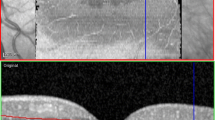Abstract
Retinal edema should be defined as any increase of water of the retinal tissue resulting in an increase in its volume. It may be of cytotoxic or vasogenic origin. Development of vasogenic macular edema is dependent on a series of factors such as blood pressure, blood-retinal barrier permeability, retinal cell damage, retinal tissue osmotic pressure and retinal tissue compliance. Objective measurements of retinal thickness are now possible using the Retinal Thickness Analyser. Localised measurements of blood-retinal barrier permeability may also be obtained using the Retinal Leakage Analyser, a modified confocal scanning laser fluorometer, while obtaining simultaneously angiographic images of the choroid and retina. These new imaging techniques show that cytotoxic and vasogenic retinal edema may occur independently in the early stages of diabetic retinopathy. These findings offer new perpectives for designing novel therapeutic strategies.
Similar content being viewed by others
References
King H. The epidemic of NIDDM: an epidemiological prespective. Int Diab Fed Bull 1995; 40: 10-12.
Cohadon F. Protection Cérébrale. Bases Conceptuelles et Applications. Paris: Arnette Blackwell, 1995; 1-184.
Cunha-Vaz JG, Travassos A. Breakdown of the Blood-Retinal Barriers and Cystoid Macular Edema. Surv Ophthalmol 1984; 28 (suppl): 465-92.
Zeimer R, Mori MT, Khoobehi B. Feasibility test of a new method to measure retinal thickness noninvasively. Invest Ophthalmol Vis Sci 1989; 30: 2099-105.
Lobo C, Isidoro I, Simões PC, Leite E, Sander B, Cunha-Vaz JG. Topographic vitreous fluorometry using a modifed confocal laser scanning ophthalmoscope. Invest Ophthalmol Vis Sci 1996; 37 (suppl.): 611.
Puliafito CA, Hee MR, Lin CP, et al. Imaging of macular disease with optical coherence tomography. Ophthalmology 1995; 102: 217-29.
Murta JN, Serra, Cunha-Vaz JG. Characterization of D-glucose transport across diabetic retinal vessels. Invest Ophthalmol Vis Sci 1996; 37 (suppl.): 979.
van Enden M, Nyengaard J, Ostrair E, Burgan JH, Williamson JR. Elevated glucose levels increase retinal glycolysis and sorbitol pathway mechanisms. Invest Ophthalmol Vis Sci 1995; 36: 1675-85.
Corbett JÁ, Tilton RG, Chang K, et al. Aminoguanidine, a novel inhibitor of nitric oxide formation, prevents diabetic vascular dysfunction. Diabetes 1992; 41: 552-6.
Parving H, Larsen M, Hossonel E et al. Effect of antihypertensive treatment on bloodretinal barrier permeability to fluorescein in hypertensive type 1 (insulin-dependent) diabetic patients with background retinopathy. Diabetologia 1989; 32: 441-4.
Cunha-Vaz JG, Lobo C. Medical therapy of diabetic retinopathy. Exp Ophthalmol 1998; 24: 1-5.
Author information
Authors and Affiliations
Rights and permissions
About this article
Cite this article
Lobo, C., Bernardes, R., Faria de Abreu, J.R. et al. Novel imaging techniques for diabetic macular edema. Doc Ophthalmol 97, 341–347 (1999). https://doi.org/10.1023/A:1002479823690
Issue Date:
DOI: https://doi.org/10.1023/A:1002479823690




